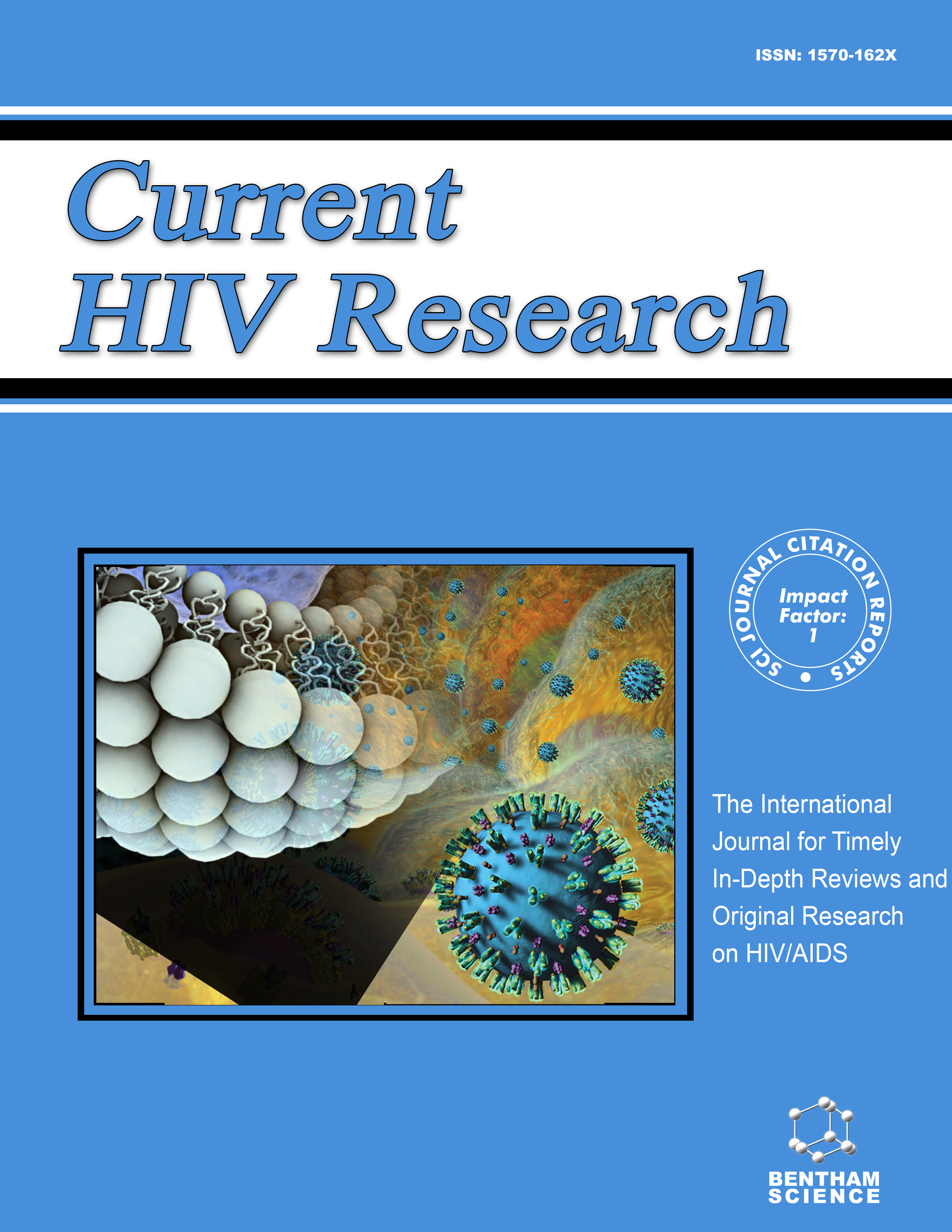- Home
- A-Z Publications
- Current HIV Research
- Previous Issues
- Volume 12, Issue 5, 2014
Current HIV Research - Volume 12, Issue 5, 2014
Volume 12, Issue 5, 2014
-
-
Drug Resistance Mutations from Whole Blood Proviral DNA Among Patients on Antiretroviral Drugs in Zimbabwe
More LessIntroduction: There are more than 500 000 HIV-infected people on antiretroviral treatment (ART) in Zimbabwe with very limited laboratory monitoring. To ensure effective treatment and prevent transmission of drug resistance, affordable treatment monitoring is needed to guide individual treatment. Methods: 125 whole blood samples from patients on first-line ART were investigated for drug resistance mutations Read More
-
-
-
Chronic, Highly Productive HIV Infection in Monocytes During Supportive Culture
More LessAuthors: Manisha Saini and Mary Jane PotashPeripheral blood monocytes of HIV-infected individuals carry virus, constituting one potential reservoir. However, most studies of infection in tissue culture find monocytes refractory to HIV replication, suggesting that culture conditions limit the relative susceptibility of this target cell. We employed a tissue culture system optimized for maintenance of human monocytes without differentiation and compared HIV infection e Read More
-
-
-
A Novel Integrase Targeting Agent to Explore the Future Prospective of HIV Eradication: Dolutegravir
More LessOut of the 15 discrete proteins encoding the total amount of genetic information in the chromosomes of human immunodeficiency virus type 1; three perform the vital enzymatic functions i.e. a reverse transcription, an integration, and proteolysis. The HIV integrase is the new validated drug target against AIDS amongst all essential enzymes due to the lack of the human homologue. In last few years quite, a few but potent inh Read More
-
-
-
Efficacy, Tolerability and Virological Consequences of Long-Term Use of Unboosted Atazanavir Plus 2 NRTIs in HIV-Infected Patients
More LessAuthors: S. Bonora, A. Calcagno, O. Vigano, P. Bigliano, L. Marinaro, E. Colella, G. Orofino, L. Trentini, M.C. Tettoni, A. D'Avolio, S. Mercadante, M. Galli, G. Di Perri and S. RusconiPurpose: Switch to unboosted atazanavir (ATV) is an attractive option due to convenience and tolerability in HIV-positive patients. With limited available data we investigated the determinants of long-term efficacy and the consequences of virological failure of unboosted atazanavir-based regimens. Methods: Retrospective analysis in two Italian large outpatient clinics including demographic, immunovirological, resistance a Read More
-
-
-
2´,3´-Dialdehyde of ATP, ADP, and Adenosine Inhibit HIV-1 Reverse Transcriptase and HIV-1 Replication
More LessThe 2´3´-dialdehyde of ATP or oxidized ATP (oATP) is a compound known for specifically making covalent bonds with the nucleotide-binding site of several ATP-binding enzymes and receptors. We investigated the effects of oATP and other oxidized purines on HIV-1 infection and we found that this compound inhibits HIV-1 and SIV infection by blocking early steps of virus replication. oATP, oxidized ADP (oADP), and oxidized Aden Read More
-
-
-
Improved Survival with Co-Trimoxazole Prophylaxis among People Living with HIV/AIDS Who Initiated Antiretroviral Treatment in Henan Province, China
More LessAuthors: Qian Zhu, Liming Wang, Wen Lin, Marc Bulterys, Wenjie Yang, Dingyong Sun, Zhaolin Cui, Jonathan Kaplan, Nora Kleinman, Xiaoyu Wei, Jessica Chung and Zhe WangObjectives: This study aims to evaluate the effect of co-trimoxazole (CTX) prophylaxis on mortality reduction among HIV-infected patients receiving antiretroviral therapy (ART) in Henan Province, China. Design: We conducted a retrospective study. Methods: All individuals aged 15 years and older who initiated ART between 2008 and 2010 in Henan Province with completed CTX prophylaxis treatment information were included. The Read More
-
-
-
The Combination of Pill Count and Self-Reported Adherence is a Strong Predictor of First-Line ART Failure for Adults in South Africa
More LessBackground: Suboptimal adherence to antiretroviral therapy (ART) is a strong predictor of virologic failure (VF) among people with HIV. Various methods such as patient self-report, pill counts and pharmacy refills have been utilized to monitor adherence. However, there are limited data on the accuracy of combining methods to better predict VF in routine clinical settings. We examined various methods to assess adherence i Read More
-
Volumes & issues
-
Volume 23 (2025)
-
Volume 22 (2024)
-
Volume 21 (2023)
-
Volume 20 (2022)
-
Volume 19 (2021)
-
Volume 18 (2020)
-
Volume 17 (2019)
-
Volume 16 (2018)
-
Volume 15 (2017)
-
Volume 14 (2016)
-
Volume 13 (2015)
-
Volume 12 (2014)
-
Volume 11 (2013)
-
Volume 10 (2012)
-
Volume 9 (2011)
-
Volume 8 (2010)
-
Volume 7 (2009)
-
Volume 6 (2008)
-
Volume 5 (2007)
-
Volume 4 (2006)
-
Volume 3 (2005)
-
Volume 2 (2004)
-
Volume 1 (2003)
Most Read This Month
Article
content/journals/chr
Journal
10
5
false
en


